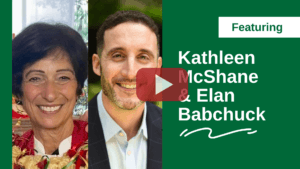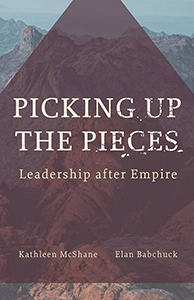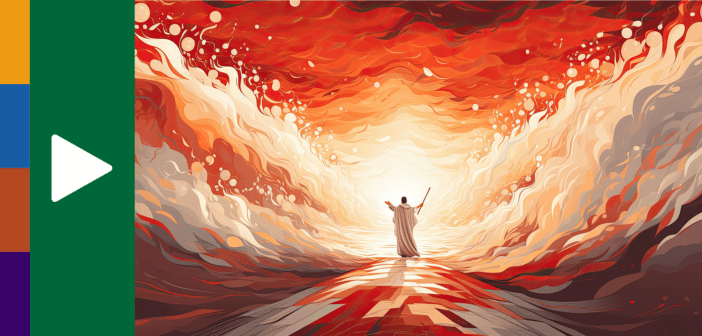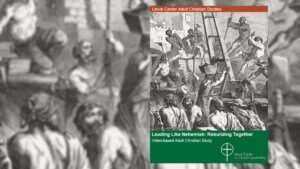
How can an innovative exploration of Moses’ biblical narrative offer a more generous leadership model for today’s religious leaders? In this episode, Kathleen McShane and Elan Babchuck, authors of Picking Up the Pieces: Leadership After Empire, ask how God is calling you to a leadership model in which power is shared so that power multiplies, and people are connected to God and each other.
Listen on Apple Podcasts | YouTube Music | Spotify
Watch on YouTube

Read in-depth article
- Transcript — Click or Tap to Read
-
Announcer: Leading Ideas Talks is brought to you by the Lewis Center for Leadership of Wesley Theological Seminary in Washington, DC. Subscribe free to our weekly e-newsletter, Leading Ideas, at churchleadership.com/leadingideas.
Leading Ideas Talks is also brought to you by Leading Like Nehemiah: Rebuilding Together. This six-session video-based study curriculum lifts up key themes in Nehemiah’s witness that can inspire and guide faith leaders today. Learn more, watch an introductory video, and view sample Study and Discussion Guide pages now at churchleadership.com/nehemiah.
How can an innovative exploration of Moses’ biblical narrative offer a more generous leadership model for today’s religious leaders? In this episode, Kathleen McShane and Elan Babchuck, authors of Picking Up the Pieces: Leadership After Empire, ask how God is calling you to a leadership model in which power is shared so that power multiplies, and people are connected to God and each other.
Doug Powe: Welcome to Leading Ideas Talks, a podcast featuring thought leaders and innovative practitioners. I am Douglas Powe, the director of the Lewis Center and your host for this talk. Joining me is Reverend Kathi McShane, co-founder of Changemakers Initiative and the director of Learning and Innovation of Texas Methodist Foundation and Wesleyan Impact Partners. And Rabbi Elan Babchuck, who is the executive vice president at CLAL, the National Jewish Center for Learning and Leadership. They are the authors of Picking Up the Pieces: Leadership After Empire. This is a wonderful book, and our focus for this talk is on leadership. I am excited to have both of you and love reading the book.
Kathi McShane: Thanks, Doug. It’s so good to be here with you.
Doug Powe: I want to jump into the book, and let me begin with the really easy, obvious question: Why Moses?
Rabbi Elan Babchuck: You know, in today’s lexicon of leadership, we tend to use terms like brave leadership, visionary leadership. We often talk about charismatic leadership, as well. We certainly revere it. We lionize those models of leadership, many of which come, Kathi, no offense, from Silicon Valley, right? This, the myth of the garage; “I’m the one who figured it out.” And it’s really damaging. I think it is really deeply damaging to the people who don’t see themselves in that model, to others who don’t even want to see themselves in that model. “Gosh, I’m a generous person. I’m a collaborative person. I like being with others. I’m a community organizer by nature. I like to be curious instead of certain. I like to be generous instead of hoarding.” Whoever it is that don’t see themselves in that model, this book’s for you. And, if you do see yourselves in that “I’m the charismatic person. I alone can fix it. I love sitting at the top of the pyramid, even though it’s challenging sometimes; especially when the world feels very volatile and topsy turvy,” you know—it’s for you too, right?
So, why Moses? Because universally, we have looked at Moses for thousands of years through the lens of, in Jewish tradition, we say: “Lokam be Yisrael kemoshe’od.” There has never been a prophet like Moses that has come up. He was one of one. And our argument is, and the reason why we picked him, was in some ways we wanted to actually deconstruct that myth. So much of the mythology about Moses’s impenetrable leadership came after Moses’s death, came after the Bible, right? It was the later commentaries that looked back on him and made up these, and sort of embellished his resume, right? After the fact. And I think there’s certainly a place and a time where that can be healthy to revise history so that we have a cleaner narrative, right? We do that all the time. But I also think that clinging to that clean version of the narrative about Moses, the infallible leader; the one who was born a leader, died a leader, and led perfectly— that narrative is actually doing a lot of damage.
Kathi McShane: I’ll just add to that, that one day while we were working on the Changemaker stuff together, Elan said something about Moses really not having become his full self as a leader until his very last sermon, while they were at the edge of the promise land. And when he said to the people, “you choose: life or death.” And it was really at that moment that his leadership became full and perhaps even all that God hoped it might be. And a light bulb went off for me then; that was so … it was so personal for me to hear Elon say that. I was at what I thought was the end of my career in pastoral ministry, and I realized in the course of doing the Changemaker work that I had most of my years of leadership been leading differently than the way I was learning to lead now. I had led in a way that I was the visionary. I was supposed to have all the good ideas … I could lead everyone else because I could do their jobs better than anybody else. I could do all the jobs, and it served me well. But what I was learning in the Changemaker work was that my job was to invite and empower everyone in the organization to participate in leadership with less focus on me at the top of the pyramid.
And suddenly, Moses’s whole story sort of became this sort of treasure for us to look at. Like, how did Moses get from that kind of leader, who sat at the feet of Pharaoh to learn how to be a leader, from there to the point where he’d said to the people, “I’m not in charge of you anymore. I won’t be, you choose.” And that’s when they grew into the fullness of the people, being the people of God, the people of Israel. So, that whole story of the Exodus and the little vignettes that we pulled out to say these are the moments when Moses was learning those important lessons—that became really the frame for the book.
Doug Powe: Yeah, I appreciate the answer and in particular, the sort of way it interrelates to your personal stories. Let me push both of you a little bit, quickly, to think about one of the challenges, I think, in the church is church individuals often amazingly can have wonderful, important jobs in the secular world. But when they get into church, they really are looking for “the pastor to be the visionary,” to be the very myth you’re fighting against: against Moses. So, how do you—so it’s a culture change not just sort of for the pastor but also for those in the church—so, how do you all sort of help congregations think about this differently?
Rabbi Elan Babchuck: That’s a great question. Look, I think there are some congregations where they are really designed as a spectator sport and that’s okay, right? That’s okay. But if we are going to live into that model, the spectator sport model, the sage on the stage, and we’re here to witness, right? Or, then we have to be really honest about asking ourselves: are we in the transformation industry or the entertainment industry? Okay. And by the way, they are both wonderful industries. They really can be, and I don’t mean that cynically. You can give a great sermon and people can walk home and be moved by it and be better in their lives. And I also believe that whether they tell you or not, and whether they say it or not, I really do believe that people are yearning to be needed, right? It’s great for a community of belonging to make sure that you’re named, make sure that you’re known, make sure that you’re noticed, but I believe that the highest form of belonging in a community is to be needed. And so, that’s the invitation, right? That’s the … I think that’s the invitation for every community leader to say, “okay, I know it says in the charter that you want me to do everything and be everything. The other question that I would invite you to reflect on is how sustainable do you think that ‘everything’ is?” We just went through COVID. They had to be everything. Every pastor I know, had to be everything, and they had to be an IT professional, right? Because they were, every one of them, was dealing with the—“Hey! I can’t log into Zoom, Pastor. Can you fix this?” It’s “I’m sorry, I’m trying to give a sermon.” And so, to be everything to everyone at all times, I think, is a really dangerous model—that space-taking model—also, really does wear the pastor, the rabbi, the imam really thin. So, it’s a dangerous model.
Kathi McShane: I totally agree with Elan. I think we’ve created that passivity in people, in churches, in congregations. I used to think people would say, “Well, I think the church should do this.” And I’d say, “Who do you think the church is?” Right, like, it’s not a standalone institution apart from the people who are part of it. But we, when we focus on the institutionality of this ‘thing’ that we are about, then people, you know, maybe there’s a small place we let people plug in. “Will you serve coffee on Sunday? We need somebody to hand out bulletins. Somebody needs to serve on the finance committee.” But I think we leave so much on the table of what people have and can offer. I don’t think we’re curious enough about what it is that people bring to, with them, and make the church a place where it will—the shape of it—will bend around people’s gifts and offerings. I think Elan’s right, that people long to participate more fully. But they don’t have a sense that what they bring is needed by the church, and we don’t do a very good job of making those connections.
Rabbi Elan Babchuck: Kathi, it’s the difference between the golden rule and the iron rule, right? The golden rule is we do unto others as you would have them do unto you, or in Judaism, actually the sort of it’s the reverse. It’s that which is hateful to you do not do unto others, but either way, it’s the reciprocal. The iron rule is never do for someone else what they can learn to do for themselves. That’s a whole different way of showing compassion and making sure that people feel beloved. It’s actually giving them the space, the tools, for them to learn how to do it themselves.
Kathi McShane: So really, what’s at the center of this way of leadership is to listen. Not to speak, not to say, not to know—but to listen to what it is that people have and bring and want for their own fullness of life.
Doug Powe: Alright, now I have to get to the pyramids because that is central to the book. So, why don’t you share a little bit about pyramids and how pyramids relate to leadership? I don’t think most people have thought about pyramids and leadership together. So, I appreciate the way that you all made the connection.
Kathi McShane: We start with organizational charts. Virtually every organizational chart in our society is shaped like a pyramid, right? Whether it’s the church or educational organizations or corporate organizations or government, right? Somebody at the top and everybody else fans out from there and everyone occupies their own little space in the pyramid. That’s just the structure of how organizations are put together. And we have this story in our faith tradition that, really, it’s central to us, in which God says, “those pyramids are houses of death,” right? God says, “let me get you, people I love, away from the pyramids because they are killing you.” And we keep saying, “But no! We want to go back to the pyramids. The people in the story of Exodus did, and we do it in all kinds of ways, too. Wait! They work, they’re efficient, they’re effective; look how well pyramid structures work. They make everything happen in a productive, efficient way.” And so, the metaphor, which really, we’ve inherited not from our faith convictions, but from the culture, right? Pyramids have been the way societies have ordered things since the time of the Egyptians, right? We didn’t … That doesn’t come from our theological imagination; that comes from our cultural absorption of that model.
You know, there have been people who have studied and promoted and thought about flatter models of leadership for a very long time. We have a couple of chapters in the book where we talk about cultural models of people who have promoted these ideas that leadership can be done in a different way. But they’ve never sort of grabbed our organizational imagination because as soon as organizations get stressed in some way—they need more productivity or efficiency or profit, right? They snap right back into that pyramid shape. And so, we are really arguing, I think in this book, provoking (we hope), a thought that our organizations, our communities that are organized by our theology and our community with one another, are the perfect places to sustain a long-term experiment, of what it might be to move ourselves away from pyramids, and in our organizational structures, and ways of leadership, and to try something else. We have a … the society needs to learn something about how non-pyramid-shaped organizations might work, and we are the people who might lead the way in showing that.
Church leaders have always looked to scripture for wisdom on how to fulfill their callings. Leading Like Nehemiah: Rebuilding Together lifts up key themes in Nehemiah’s witness that can inspire and guide faith leaders today. Available as an online course from Wesley Pathways for Ministry and also a six-session video-based study curriculum.
Doug Powe: And, Elan, before you jump in, maybe you can pick it up from this angle: I’m really struck again by the image that we literally are reliving the story by wanting to go back to Egypt or go back to the pyramids. You all talk about some ways to avoid doing that. So, if you could maybe share one or two of those ways. I don’t want to give away too much of the book because I want people to get it. But if you could share one or two thoughts of how we can avoid falling into that trap and continuing to live that narrative.
Rabbi Elan Babchuck: Look, it would be a lot easier if I could tell you, “look around and if you notice any pyramids, I don’t know—stay away. Or go, go the other direction, or go around.” It would be much easier if they were readily noticeable, right? And it would be easier if the pharaonic behaviors that we exhibit were readily noticeable. But oftentimes, pyramid kinds of power, they operate very subtly, and you can almost not notice them if you’re not paying attention. We have this story about being in a brainstorming session where everybody’s coming up with the great ideas. And then of course, like, the CEO or the senior pastor, they’re sitting in the room, and of course, the second they give a subtle head shake, “Oh, that’s a terrible idea. We never should have proposed it. Onto the next thing.” And then, this—their body language leans in. “Ooh, that must be a good one,” right?
Power works in really invisible ways, but that’s what makes it so dangerous, right? When we are not aware of the ways that we exercise power, and when others maybe can’t even notice the ways that they exceed to our use of that hierarchical coercive extractive power. So, what I would say is: eyes open, right? And be really reflective. If you’re a leader and you’re wondering, “gosh, I wonder if I …” you need to have a trusted colleague, mentor, friend, partner who can really hold up a mirror for you that you can hear, right? If what you find is that your executive committee looks more like a wartime cabinet of yes people, then it’s probably the wrong crew, right? You might need some people who will actually challenge you—lovingly—but will challenge you.
Doug Powe: Let me shift a bit, and Elan, I’m going to stay with you, and have you share a bit of your story from chapter four of the realization that building something that lasts really means encouraging ownership from those in the community, and it can’t just be about the leader. This builds on what you all have been saying, but I think your personal story really helped bring this to light.
Rabbi Elan Babchuck: Yeah, thank you for that. Thank you for that invitation. So, special needs work and building special needs community has always been something extremely important to me for a myriad of reasons. And every stop along the way in my leadership journey, I’ve been really grateful to be a part of building communities with families and children with special needs, specifically. And when I got to this synagogue, I served a large synagogue in Providence, Rhode Island, starting in 2012, and when I got there, what I found was that there really weren’t all that many community members who had special needs or had children with special needs. There were just not many families with children with special needs or adults with special needs. And so, I thought, gosh, why is this happening? I did some exploration. And actually, it wasn’t even my active research and networking. It was … I was sitting at a coffee shop wearing a kippah, and someone comes in and says, “Are you the new rabbi?” And I’m thinking, oh, how wonderful. It’s like—Providence, Rhode Island—everyone’s a celebrity. It’s great, this person, and then they said, “I will never go to your synagogue. I will never step foot in that synagogue because when my child was in the sanctuary making noise trying, singing along to the prayers, it was constant shushing. People were turning around and shushing, shushing, shushing.” I said, “Wow, that’s really not the culture that I would want to be a part of, please understand. Will you tell me more?”
Eventually, and I’ll sort of cut to the chase, this person actually became the leader, right, of, of building this community of families and children with special needs. And it was such a joy taking this community organizing approach of every single person had a gift to give. And really the work was about activating those gifts and creating the space. The physical space inside the chapel. That meant like bean bags and a paint job and some colorful stuff and poster, all that stuff. But also, the existential, spiritual space for people to really feel beloved in that community after decades of not feeling that way. The one thing that I continued to do was lead the prayer services. We had monthly prayer services, and it never even occurred to me, “gosh, maybe I should train others to do this,” and it doesn’t really matter if we hit every note, and if the all the liturgy is exactly as it’s written down and if the choreography is all right. Actually, what matters most is, do people feel like they’re connected to God and connected to one another in this space? And in my mind, I didn’t ask that question. Who else might want to hold this space? Who else might want to hold this space?
I left the synagogue in 2016, after we had raised an endowment to ensure that this community would continue to grow and be served in perpetuity. And six months, nine months, 12 months later, the community stopped meeting. And what I came to realize, actually, I was just speaking this morning with the gentleman who made the endowment gift in his late brother’s honor, and what really broke my heart was that all the pieces were in place. They had the right people. They had the funding. They had the space. They had the will. They had the momentum. But what I failed to do was follow the iron rule, which was that I didn’t give them space to learn to do it themselves.
Doug Powe: Thank you. And Kathi, similar but different. You were a lawyer, and you shared about being a lawyer and your experience, and how that has helped you also to think differently about leadership.
Kathi McShane: Yeah. Thanks for asking me about that embarrassing story, Doug. I did. I practiced law for 15 years before I went to seminary. And I was a good lawyer; I had high standards and was a partner in a small law firm that, I will just confess, we went through a lot of associates. We would hire someone for the litigation practice that I headed up. And one after another, I would find ways in which they didn’t, that associate, didn’t quite measure up to the standards I had for the work that was coming out of the firm. So, a number of associates who either came for a while and left, or who we dismissed because they didn’t quite match what I thought the lawyers in our firm ought to look like or how their work ought to look. And I look back now and think: “Why wasn’t I more concerned with investing in them and helping them become something perhaps more than they were at that point.” That they could have been learning if I could have seen it as a learning opportunity for them and for me. Not that my work as a leader was not to hold to be first committed to the standard of excellence that I was focused on, but instead the people. That, I think, would have made a lot of difference in the way that I led. I think I was hard on people.
You know, a lot of times people ask us about the book, “isn’t what you’re proposing a leadership where everyone gets to share, and isn’t that just a recipe for chaos?” Right? Either, just paralysis, where everybody has a voice and so you do nothing, or chaos where everybody thinks they’re a leader and the organization just … there’s entropy. And the story I often tell when people ask that is think about inviting your child into the kitchen to make cookies with you, right? It’s something we do, and you don’t do it because the cookies come out better. And in fact, your kitchen is going to look like a mess at the end of that experiment. But you do it because there are more important things at stake than the quality of the cookies and the condition of your kitchen, right? Because the relationship that you have with that child is the most important thing, and this is a bonding experience. And I think what we are trying to say in this book, and what I feel like I have learned from myriad mistakes in my leadership, is that people are more important. You have to think that relationships and people, sort of the flourishing of people in the organization, is more important than any accomplishment or you know, production goal. It took me a long time to learn that.
Doug Powe: Thank you both for sharing those stories. Unfortunately, we do need to bring this to an end. I’m really enjoying the conversation, but I want to have you share on sort of what you call the “mosaic cycle.” Where you, at the end, talk about dreaming, disturbing, and distancing. In terms of thinking about ways that we can actually move forward together so we can help people to see the nice picture of what is possible. Because I think that is important. So, I’ll let you each have a last word sort of sharing about that mosaic cycle.
Rabbi Elan Babchuck: Yeah, thank you for that, that invitation. Dreaming, disturbing, and distancing. Really, the main reason why we were leaning towards a cycle, right, and not a linear process is the same reason why we don’t offer, “Hey, this is a 10-part blueprint for transforming your leadership and transforming your community, and here’s how you negotiate every step,” is that it’s a really emergent process. And the truth is that, going back to the pyramid point, pyramids were not places of life. They were tombs, they were burial tombs. So, in order to get away from that pyramid model, we need to ask ourselves: “is love flowing through our community? Is power flowing through our community? Are all of the resources and access and connections, are they all flowing through the community in such a way that every person feels like they have, like they can partake, like they’re invited to be a part of that of telling that story?”
And so rather than a linear path: “Okay, you change this, then you do this, and then you’re done. You can retire now. Everything’s good in perpetuity.” We really wanted to make it clear, that this is the kind of thing, like life, the life cycle, that needs to be nurtured over time. And even if you feel like, “gosh, I just took two steps back,” look at, that’s why we underlined or highlighted Moses’ journey because he does the very same thing. But at the very end of his speech, from a Jewish perspective, when we finish reading Deuteronomy, you know the next thing we do? We start reading Genesis, right? We don’t jump to Joshua, right? We finish the five books, and then we start them again in the very same breath. And I think that’s what we’re inviting people to imagine. That, okay, you’re in the messy part right now and everything’s kind of getting disturbed. And of course, this is what we feel like in the world, especially in an election year. Everything feels like it’s topsy turvy. That’s exactly where we need to be right now because from here on out that’s going to give us an opportunity to then move through this change before we try to solidify anything. And so that’s the invitation.
Kathi McShane: And I’ll just add to that. I’ve learned so much from Elan about this story of the exodus and this cycle of reading the Torah and coming right back. And I think I’ve started to sort of internally experiment with the idea that you know, they actually never get to the promised land. They get to the place they thought was the promise land in the story of the Exodus, I think once they’re there, it doesn’t feel like the promise land, right? And so, really all of the good things that happened in their relationship with God and the growth and in their becoming a people happened out in the wilderness. And so, in the Changemaker work, I’ve shifted from thinking that what motivates churches—when we think about congregations becoming more risk-taking organizations—what really motivates them to do that, not to be some vision of the end; really, the hurdle that people and churches have to get over is to step into the wilderness. All the good stuff happens in the wilderness. All of it, right? It’s where we become. And if our faith, our spiritual process, is this process of becoming, we’re going to have to stay in the wilderness for a long time, right? Maybe always, maybe our lives should always feel like we are out there in that mix of discomfort, so that we’re being stretched all the time. So, I do think it’s a cycle. I don’t even think our faith story has a known telos; that is, it maybe is our vision that we have it, but we never arrive there.
Doug Powe: Thank you both. It’s a wonderful book, Picking Up the Pieces: Leadership After Empire, and I appreciate your taking the time today to share.
Kathi McShane: Thanks so much, Doug. It’s good to be with you.
Rabbi Elan Babchuck: Such a joy, thank you.
Announcer:Thank you for joining us for Leading Ideas Talks.
Don’t forget to subscribe to our free weekly e-newsletter, Leading Ideas, to be notified when new episodes are published. Visit churchleadership.com/leadingideas.
 Picking Up the Pieces: Leadership After Empire is available at Fortress Press, Amazon, and Cokesbury.
Picking Up the Pieces: Leadership After Empire is available at Fortress Press, Amazon, and Cokesbury.
Related Resources
-
- Leading as Moses Led by Emanuel Cleaver III
- It Takes Teamwork by Kevass J. Harding
- Leading When You Don’t Know the Way by Susan Beaumont
Photo by PhotoGranary on Lightstock





